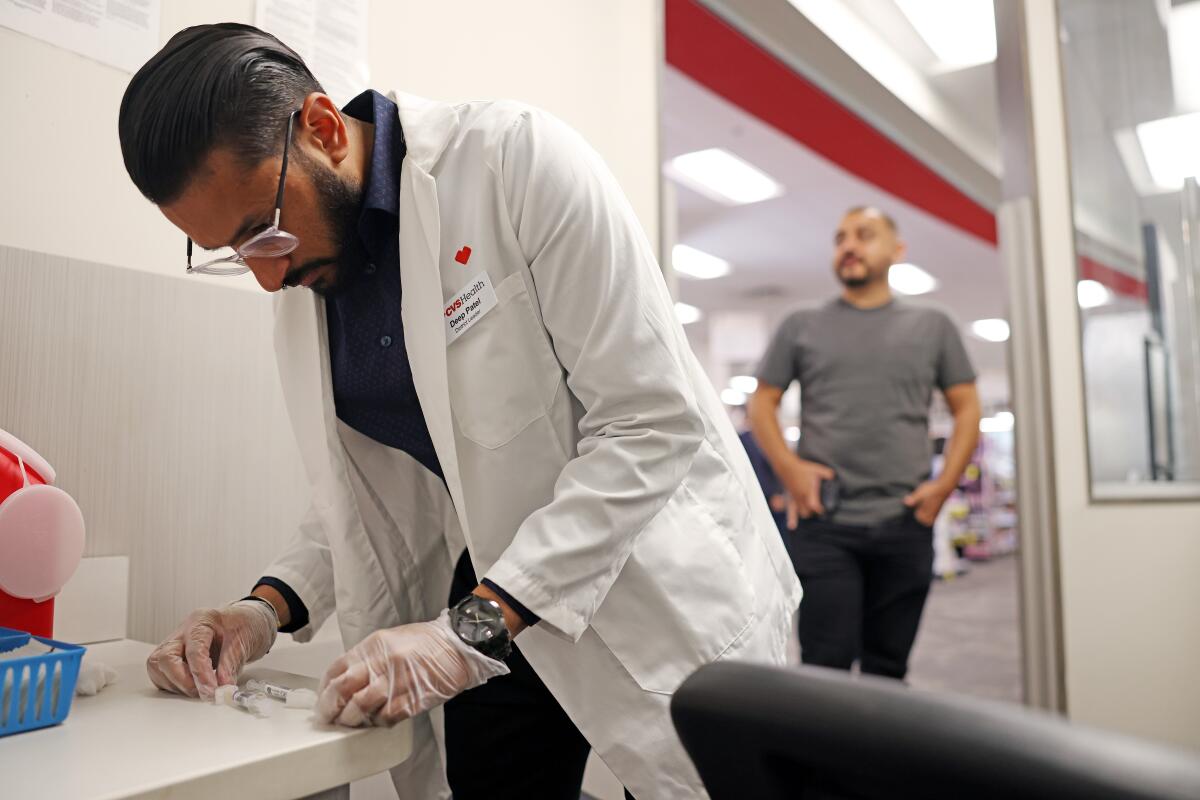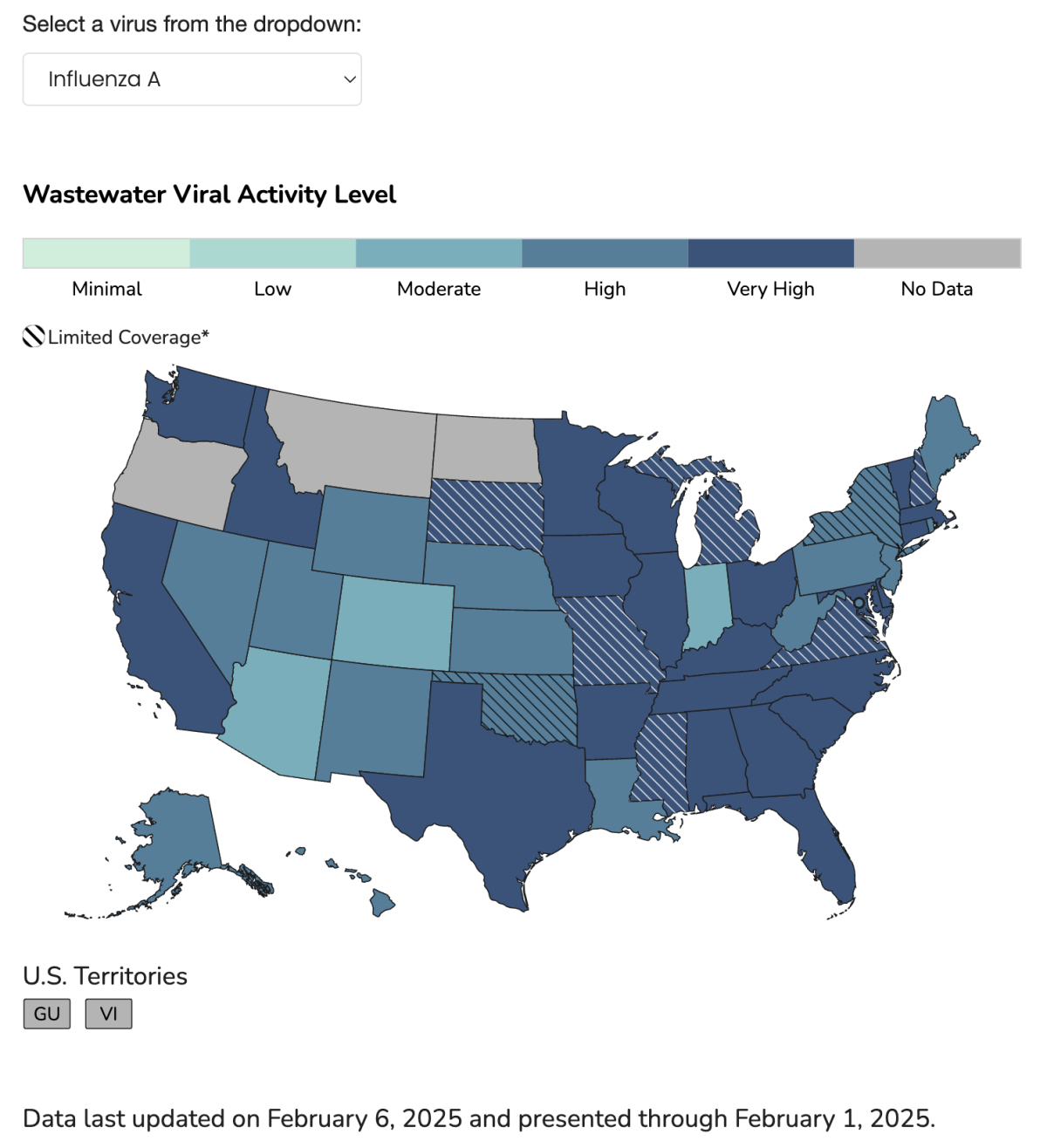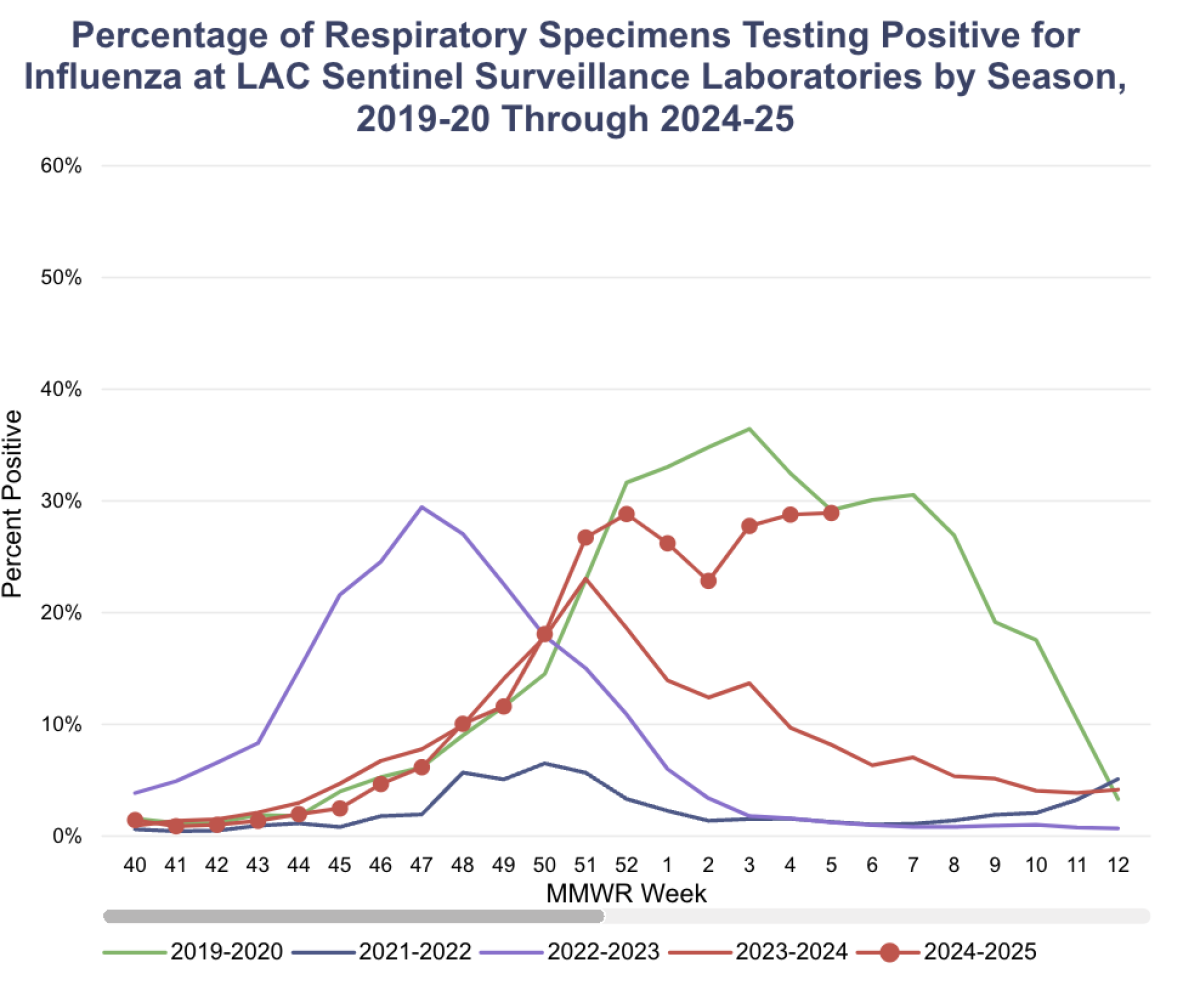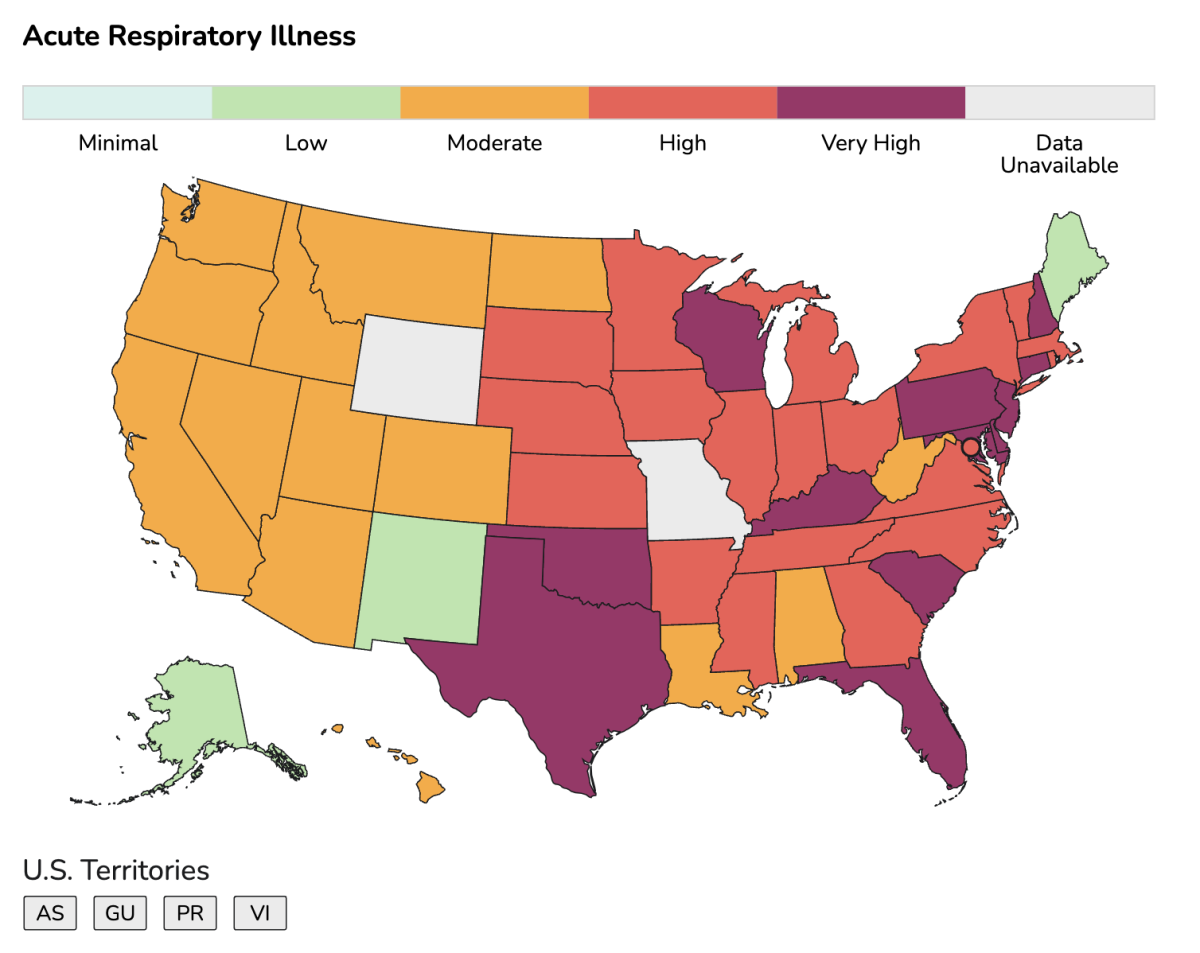
This year’s flu season is shaping up to be one of the most severe in recent memory for California, resulting in a notable increase in hospital admissions. Health officials are cautioning that the virus could remain prevalent for several weeks.
Data from the California Department of Public Health indicates that this flu season has already surpassed any previous season since the beginning of the COVID-19 pandemic in early 2020. Notably, the positivity rate for flu tests at the state’s clinical sentinel laboratories soared to 27.8% for the week ending February 1, marking a significant rise.
This level is higher than the peak seen during the “tripledemic” of the 2022-23 winter, characterized by a concurrent surge of flu, COVID-19, and respiratory syncytial virus (RSV) that strained California’s healthcare system.
“We are still climbing,” commented Dr. Peter Chin-Hong, an infectious disease specialist at UC San Francisco, highlighting a shift where flu is dominating discussions over COVID-19. He pointed out that this marks a pivotal moment since the pandemic’s inception, focusing primarily on influenza now.

The rate of positive flu tests in California’s clinical sentinel labs has reached a five-year high.
(California Department of Public Health)
Tragically, there have been at least 10 reported flu-related deaths among children in California this season, including three teenagers from San Diego County, as outlined by the Department of Public Health.
“The recent flu fatalities among our youth are deeply concerning as we approach what is historically the peak of flu season,” stated Dr. Ankita Kadakia, the interim public health officer for the county.
None of the teens had received a flu vaccine, which Dr. Kadakia emphasized as “the best defense against serious illness.” On a national level, the U.S. Centers for Disease Control and Prevention has recorded at least 11,000 flu-related deaths this season, including 47 among children, alongside over 250,000 hospitalizations.
Dr. Chin-Hong noted that the COVID-19 pandemic may have led to a perception that children are not as severely impacted by such viruses, but he stressed that influenza can indeed cause severe complications in children. Pediatricians have reported a significant increase in flu cases among young patients recently.
This winter has seen a notably low influenza vaccination rate for children, which is the lowest recorded since at least the 2019-20 season. Nationally, by late January, only 44.5% of children aged 17 and younger were vaccinated against the flu, a decline from 49.1% compared to the same time last year and 51.7% from the year before.

Flu vaccination rates among children in California have declined to their lowest level since at least the 2019-20 flu season.
(Centers for Disease Control and Prevention)
In California, the flu vaccination rate for children stood at 47.7% by late January, the lowest since at least the 2019-20 flu season. In comparison, the same rate was at 53.7% during this same period last year.
The CDC recommends that all individuals aged six months and older receive a flu shot, ideally by the end of October, to strengthen immunity during the more active winter months for the virus.
Given the severity of the ongoing flu season, health experts urge those who have not yet received their vaccination to do so promptly.
“This flu season has been particularly prolonged and challenging compared to previous years. And it is far from over,” stated Dr. Kadakia.
Currently, the predominant strains of the flu virus in circulation are H1N1, related to the swine flu outbreak of 2009, and H3N2, known for causing more severe illness overall, according to Dr. Chin-Hong. Recent genetic analyses of influenza type A viruses revealed that 54% were H1N1 and 46% were H3N2.
No bird flu viruses were detected in humans recently, and public health officials maintain that the risk from bird flu remains low, as there have been no documented person-to-person transmissions. Currently, there have been 68 confirmed human cases of bird flu in the U.S., with 38 of those in California, primarily linked to contact with infected poultry or cattle.

Pharmacist Deep Patel administers a flu and COVID-19 vaccine at a CVS in Huntington Park.
(Christina House / Los Angeles Times)
In their latest respiratory virus report, California health officials noted that flu activity remains “high and increasing,” while COVID-19 and RSV cases are currently low. The current positivity rates for COVID-19 and RSV stand at 2.4% and 5%, respectively.
Experts advise that the test positivity rate isn’t always the best indicator for comparing flu seasons, given varying testing methods and healthcare utilization across different years.

Current flu activity is categorized as “very high” across California.
(Centers for Disease Control and Prevention)
High levels of influenza have been detected in California’s wastewater, with RSV levels classified as “high” and COVID-19 levels remaining low. The state has also experienced a continuous rise in flu-related hospital admissions, indicating a potential second peak for this winter season. Recent reports show the hospitalization rate reaching 10.1 new admissions per 100,000 residents, a record high for this season.

Flu hospitalizations in California are on the rise, potentially indicating a second peak.
(California Department of Public Health)
According to the CDC, emergency department visits for influenza are anticipated to remain high and may increase across most states in the coming weeks.
Recently, staff at UC San Francisco received notifications indicating that the hospital is at full capacity, with a significant number of patients hospitalized for influenza, a situation not seen in quite some time.
Los Angeles County is experiencing a similarly intense flu season, with positive flu test rates exceeding 20% for seven consecutive weeks, reaching a notable 28.83% recently.

This flu season has seen positive test rates higher than 20% for seven consecutive weeks in Los Angeles County, with the most recent figure at 28.83%.
(L.A. County Department of Public Health)
This sustained increase in positive flu tests hasn’t been observed since the 2019-20 season, which saw ten consecutive weeks of flu positivity rates above 20%. On a national scale, emergency room visits for flu are at a heightened level while RSV visits are moderate, and COVID-19 visits remain low.
Currently, the national positivity rate for flu tests has climbed to 31.6% and continues to rise. The RSV positivity rate has decreased to 6.6%, while the COVID test positivity rate has fallen to 4.9% as of the latest report.

A map demonstrates that respiratory illness levels are notably high in the eastern U.S., while California and much of the West experience moderate levels.
(Centers for Disease Control and Prevention)
As for COVID-19, the CDC projects that emergency department visits will likely remain lower this winter compared to previous years. If this forecast holds, it would represent the first winter of the COVID era without significant spikes in cases.
The lagging COVID surge seen in the previous summer and early autumn may have reduced the number of individuals susceptible to the virus this winter, as noted by the L.A. County Department of Public Health.
Additionally, the absence of new concerning COVID subvariants over the past few months may also contribute to the current situation, according to Dr. Chin-Hong.
Overall, the levels of respiratory illnesses—including flu, COVID-19, and RSV—are most critical in the eastern U.S. and moderate in California and much of the West. Vaccines are available for both COVID-19 and RSV, with health officials recommending that residents, particularly those at high risk for severe illness, consider vaccination.
In 2023, the first RSV vaccines were approved for use in the U.S. Health officials recommend that everyone six months and older receive the updated COVID-19 vaccine. The RSV vaccination is advised for individuals aged 75 and older, and for those between 60 and 74 years of age who are at elevated risk. For infants, health officials suggest maternal vaccination or administering a monoclonal antibody to mitigate severe RSV risks.
“It’s crucial to get a flu shot, along with an updated COVID-19 vaccine and RSV vaccine if eligible, especially with elevated respiratory infection prevalence in the community at this time of year,” said Dr. Rais Vohra, Fresno County’s interim health officer.
A report from the CDC’s Morbidity and Mortality Weekly Report in October indicated a drop in flu vaccination rates in various countries, including in South America, which have fallen below pre-pandemic norms.
The report also highlighted how the post-pandemic declines in vaccination coverage across the Americas are linked to vaccine misinformation, hesitancy, and disruptions in routine immunization services.
Some health experts have raised alarms over the growing skepticism regarding vaccine safety, particularly in light of statements from Robert F. Kennedy Jr., who has been nominated by President Trump to head the U.S. Department of Health and Human Services. Experts continue to assert that the nation’s recommended vaccines are safe.
“I wonder if this skepticism is part of a broader trend influenced by figures like RFK Jr., leading to more questions about vaccines,” Dr. Chin-Hong remarked. He also noted the concerning decline in flu vaccination rates among children, calling it “striking.”









